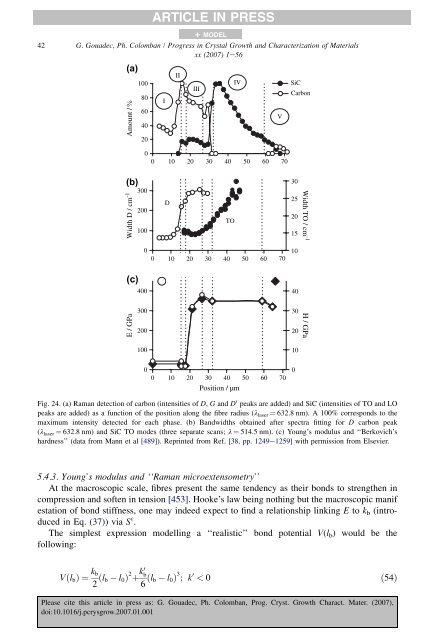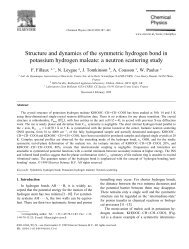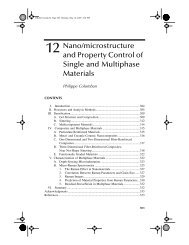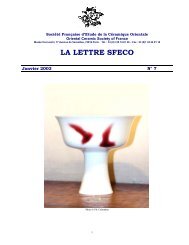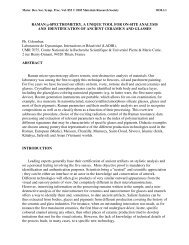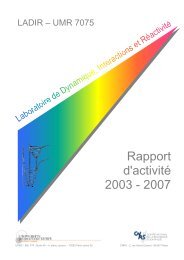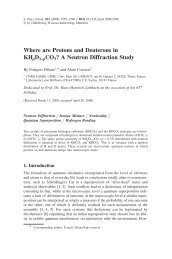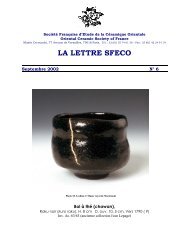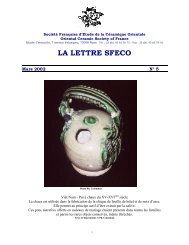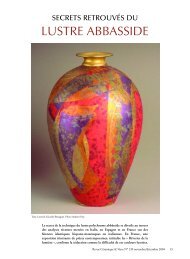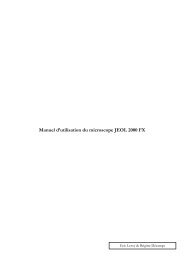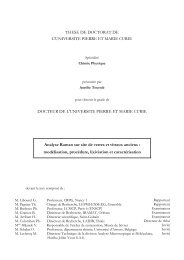Raman Spectroscopy of nanomaterials - institut de chimie et des ...
Raman Spectroscopy of nanomaterials - institut de chimie et des ...
Raman Spectroscopy of nanomaterials - institut de chimie et des ...
Create successful ePaper yourself
Turn your PDF publications into a flip-book with our unique Google optimized e-Paper software.
(a)Amount /10080604020ARTICLE IN PRESS+ MODEL42 G. Goua<strong>de</strong>c, Ph. Colomban / Progress in Crystal Growth and Characterization <strong>of</strong> Materialsxx (2007) 1e56IIIIII00 10 20 30 40 50 60 70IVVSiCCarbon(b)Width D / cm -1300200100DTO30252015Width TO / cm -1(c)04000 10 20 30 40 50 60 701040E / GPa300200100302010H / GPa00 10 20 30 40 50 60 70Position / µm0Fig. 24. (a) <strong>Raman</strong> <strong>de</strong>tection <strong>of</strong> carbon (intensities <strong>of</strong> D, G and D 0 peaks are ad<strong>de</strong>d) and SiC (intensities <strong>of</strong> TO and LOpeaks are ad<strong>de</strong>d) as a function <strong>of</strong> the position along the fibre radius (l laser ¼ 632.8 nm). A 100% corresponds to themaximum intensity <strong>de</strong>tected for each phase. (b) Bandwidths obtained after spectra fitting for D carbon peak(l laser ¼ 632.8 nm) and SiC TO mo<strong>de</strong>s (three separate scans; l ¼ 514.5 nm). (c) Young’s modulus and ‘‘Berkovich’shardness’’ (data from Mann <strong>et</strong> al [489]). Reprinted from Ref. [38, pp. 1249e1259] with permission from Elsevier.5.4.3. Young’s modulus and ‘‘<strong>Raman</strong> microextensom<strong>et</strong>ry’’At the macroscopic scale, fibres present the same ten<strong>de</strong>ncy as their bonds to strengthen incompression and s<strong>of</strong>ten in tension [453]. Hooke’s law being nothing but the macroscopic manifestation <strong>of</strong> bond stiffness, one may in<strong>de</strong>ed expect to find a relationship linking E to k b (introducedin Eq. (37)) via S 3 .The simplest expression mo<strong>de</strong>lling a ‘‘realistic’’ bond potential V(l b ) would be thefollowing:Vðl b Þ¼ k b2 ðl b l 0 Þ 2 þ k0 b6 ðl b l 0 Þ 3 ; k 0 < 0 ð54ÞPlease cite this article in press as: G. Goua<strong>de</strong>c, Ph. Colomban, Prog. Cryst. Growth Charact. Mater. (2007),doi:10.1016/j.pcrysgrow.2007.01.001


